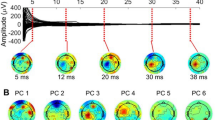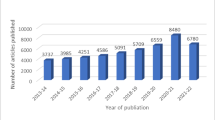Abstract
By individually examining the characteristics of conducting waves in multi-channel surface electromyogram (EMG) signals, there is a possibility to understand the mobilization mechanism of muscle contraction. It is important to consider the potential obtained from the surface electromyogram (EMG) signal conducted from a large number of moving units in the muscle, as well as the interference potential due to the conducting action potential. The main purpose of this research paper is to find the exact characteristics of conducting waves close to an end-plate using the antiphase conduction method. To evaluate the position of the end-plate, every conducting wave will be investigated by multi-channel surface EMG, and the formation process for the conducting waves will be analyzed.









Similar content being viewed by others
References
Hodgkin AL, Huxley AF (1952) A quantitative description of membrane current and its application to conduction and excitation in nerves. J Physiol 117(4):500–544
Sacco IC, Gomes AA, Otuzi ME et all (2009) A method for better positioning of bipolar electrodes for lower limb EMG recordings during dynamic contractions. J Neurosci Methods 180(1):133–137
Cavalcanti Garcia MA, Vieira TMM (2011) Surface electromyography: why, when and how to use it. Med Deporte 4(1):17–28
Merlo A, Farina D, Merletti R (2003) A Fast and reliable technique for muscle activity detection from surface EMG signals. IEEE Trans Biomed Eng 50(3):316–323
Hussain MS, Reaz MB, Mohd-Yasin F et al (2006) Denoising and analyses of surface EMG signals. In: WSEAS On-Line Proceeding, pp 306–308
Stegeman D, Blok J, Hermens H et al (2000) Surface EMG models: properties and applications. J Electromyogr Kinesiol 10(5):313–326
Mashima H (1985) Physiology, Bunkoudo, Tokyo, pp 49–75
Murakami K, Fujisawa H, Onobe J et all (2014) Relationship between muscle fiber conduction velocity and the force-time curve during muscle twitches. J Phys Therapy Sci 26(4):621–624
Andreassen S, Arendt-Nielsen L (1987) Muscle fiber conduction velocity in motor units of the human anterior tibial muscle. J Physiol 391:561–571
Beck R (2006) Muscle fiber conduction velocity, Wiley Encyclopedia of Biomedical Engineering
Buchtal F, Schmalbruch H (1980) Motor unit of mammalian muscle. Physiol Rev 60(1):90–142 (Retrieved 6 December 2012)
Odan S, Itakura N (2008) Analysis of propagating wave in multi-channel surface electromyogram (in Japanese). Human Information Processing 2008-136, pp 75–78
Kosuge T, Itakura N, Mito K (2013) A study of conducting waves by using the multi-channel surface EMG. In: 4th International Conference, DHM 2013, HCI International 2013, pp 223–231
Kosuge T, Itakura N, Mito K (2014) Conducting waves using multi-channel surface EMG, (in Japanese). IEEJ C 134(3):390–397
Author information
Authors and Affiliations
Corresponding author
Additional information
Publisher’s Note
Springer Nature remains neutral with regard to jurisdictional claims in published maps and institutional affiliations.
About this article
Cite this article
Aliabadi Farahani, M., Yamada, H., Akehi, K. et al. Analysis of end-plate using multi-channel surface EMG. Artif Life Robotics 24, 390–395 (2019). https://doi.org/10.1007/s10015-019-00531-3
Received:
Accepted:
Published:
Issue Date:
DOI: https://doi.org/10.1007/s10015-019-00531-3




